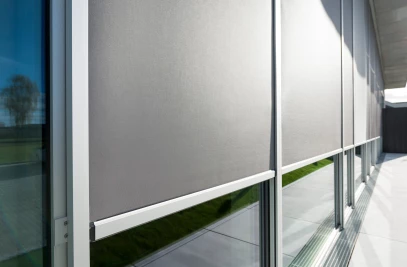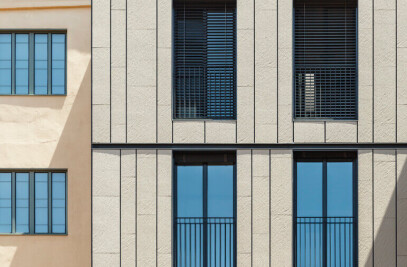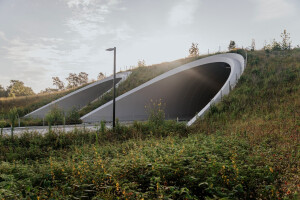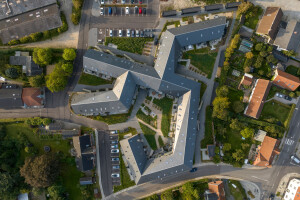Party Rent Munich‘s new headquarter convinces due to clear use of form, special spatial experiences and authentic materials. The building designed by Jarosch Architektur works as a brand space for clients as much as a showcase for tomorrow’s working environment – in the competition for qualified employees the beauty of the workplace matters as well.
Shipping and processing goods, administration, client support, concept presentation – Party Rent is the European market leader in event supply and as such its activities are manifold. So are the requirements for its headquarters. Combining its complex processes and structures in a way that is both elegant in design and functional – this was Jarosch Architektur’s mission for the new building. Together with Party Rent Munich they wanted to demonstrate that a logistic facility can be a very aesthetically pleasing place to work and spend time with a high quality of design too. ‘As with all our projects, our principle was to create aesthetics from the necessary. Architecture and function create the beautiful entirely organically, without formal décor’, the architects explain. Party Rent Munich managing directors Ben Cudok and Tobias Viße add, ‘The building needs to evolve with our team and all topics surrounding the company. It has to support our daily work.’ The new building is in operation since August 2018. An expansion of the building has already been planned for.
The architectural concept
Clearly visible from three sides, Party Rent Munich’s new building rises directly next to the A94 in Feldkirchen. The metal panel façade glistens in the sun; the three-storey building captivates due to clean lines and reduced use of form. A storage and commissioning area extending over the full height of the building is flanked by two multiple-storey wings containing offices and conference rooms. Projections and recesses in the façade are the result of moving particular volumes of the building and allow using the plot as efficiently as possible. At the same time, the clear lines in the building’s layout help users and visitors find their way easily.
The three-storey wings on the southern and eastern side of the building meet and cross functionally in the south-east corner. An impressive gallery is located at this touch point, above the entrance area on the first floor. It can be reached via the central staircase or a lift in the eye of the stairs. This meeting point serves as a lounge for informal meetings. Unrestricted views and spatial connections to both office floors can be experienced here.
Functional and social rooms are located on the southern wing’s ground and first floor. Its second floor contains a showroom that opens to a spacious, sunny balcony with a view of the nearby Alps. Both its inside and outside space can be used to present the event supplier’s products or to set up sample event designs. A show kitchen can host internal as well as external cooking events.
To the North West, a large hall offers enough room for the event equipment the company rents out. Along the eastern façade, open-plan offices are located on two floors above loading bridges for trucks. The outdoor area has two points of access: for employees as wells as clients and for deliveries. 70 parking spaces are available.
Interior
Inside the building the materiality and proportion of the façade is continued. In the company’s offices, the future of work can be experienced. The space is structured and shaped by simple glass partitions, unobtrusively framed by slim steel profiles. Thus, separate smaller offices and meeting rooms are created that offer quietness but still maintain the openness and transparency of a shared office. Directors Cudok and Viße explain, ‘Crowded workspaces restrict our productivity and creativity. Therefore, we decided on timelessly attractive open-plan offices. They also foster communication within the team. At the same time, focussed project preparation is still possible in the quiet of the single offices, which we furnished with ergonomically ideal equipment.’
A window front stretches along the entire length of the wing and floods the workplaces with natural daylight. The architectural bureau particularly designed the glass partitions to reflect the proportions of the window façade. Lines were reduced to a minimum. Where the material made cuts necessary, those were used for functional elements. The staircase’s handrail, for example, was integrated into breaks in the material of the lift shaft.
Just like outside, the interior materiality is kept deliberately ‘brut’ and straightforward. The walls were created in high-quality but still authentically rough concrete; the floor is made from raw oak wood. The oiled steel that is found in the partitions was also used for the staircase and lift. In their design, the architects made a point of reducing the materials and colours used. The result is a completely harmonic design that prevents visual distractions.
The architects’ goal was furthermore to make the construction of the building clearly visible on the inside. They emphasise, ‘In 1913, Adolf Loos said, “Do not build picturesquely. Leave that effect to the walls, the mountains and the sun.” We are convinced that beauty arises from pure materiality.’ The use of rough raw materials creates an authentic and comfortable atmosphere that allows the employees to let their creativity flow freely. Jarosch Architektur put value on buildings not being subjected to creative fashions. It is the only way these creations can endure over time without losing value. Through simplicity, reduction and restraint, buildings emerge that quietly offer the backdrop for life and the processes. They are convincing as self-contained aesthetic domains for manifold contents and activities.
Gallery where the wings of the building meet
The considered workplace architecture can be experienced especially well in the entrance area where the southern and eastern wings meet. A kind of atrium stretches over the first and second floor and is framed by a gallery towards the north and the west. Light falls not through common windows but through skylights with deep frames embedded in the elegant grid of the ceiling. The architects deliberately abstained from incorporating windows: ‘We decided to confine the atrium with windowless walls on two sides. Thus, we created an entirely introverted atmosphere – the user’s focus is steered to the inside all by itself.’
Two distinctive suspended lamps connect the two floors visually and accentuate the room with light in the evening. The detached fireplace is another connecting element. It is also made from oiled, raw steel and designed very simple, rising from the lower to the upper floor and enhancing the space, emphasising its size and inviting the visitor for a placid stay. The fireplace is also used as a place for the creative collection of ideas. The lounge furniture on both floors represents the company’s product range and can be changed according to occasion or season. A long wooden table allows for meetings in a pragmatic atmosphere. Here, the team can work together without pressure – both among themselves and with clients or partners.
Lift and staircase
A special architectural feature of this part of the building instantly opens up to the observer on entering the atrium. The different floors are connected through an open staircase also made from oiled steel that evokes associations with Art brut. In its centre, a lift carries visitors and employees up and down the building. In the style of historical Parisian buildings, the steel cage surrounding the lift car is enclosed by the staircase on three sides. The deliberate citation of a construction typical for residential buildings enhances the cosiness of the entrance area. To create the desired aesthetics the walls of the lift shaft were entirely made from expanded metal. This material offers another advantage: it is translucent. Thus, it does not only allow the environment to be experienced from inside the lift car. The light from inside the lift is also visible from the stairs. Accordingly, the lift acts as a kind of lantern and emphasises the liveliness within the building: its movements are also visible for people outside.
Light concept
Completely coherent in itself the light concept was also designed in its entirety by one firm. In close coordination with Jarosch Architecture, PSLab Stuttgart developed an impressive individual plan that also very deliberately works with shadows. They examined every individual area with regards to the requirements of the space, the workplaces, the architecture to the distribution of light.
The majority of the light is integrated into the ceiling. The lamellas of the sound insulating ceiling thus become a design element; filigree line lights are integrated in individual lamellas. Staircase and atrium are deliberately set up with large lamps; the reduced, rough style of the interior design continues in these accentuating elements. Another special feature of the light concept: the deliberately reduced interior design is not interrupted by switches. Light, air supply and heating are regulated via computer.
The company
Party Rent is a Europe-wide events supplier with 24 branches and about 950 employees in nine countries. They have been implementing holistic design concepts for events for more than 25 years, combined with a logistics service tailored to the needs of the events industry. The company’s promise is the perfect atmosphere.
The Munich branch was founded in 2013 and currently employs about 75 people. The new building’s design is directed at two target groups especially: employees and clients. To its clients, Party Rent has always presented itself as a supplier with great design competence. The product range offers countless furniture design classics but also own creations. This expertise – together with the promise of perfect atmosphere – is also conveyed by the building’s design. The building works as a brand space. It is the embodiment of the promise Party Rent wants to fulfil towards its clients.
The employees in mind
In Munich, it is not only important to convince clients but also employees and potential job applicants. The market for skilled personnel is especially hard-fought in Munich; in the strife for talents the working environment continually gains in importance. The workplace is the place where people spend the majority of their time. With the new building, the company created a modern and high-quality working environment, light-flooded spaces and an atmosphere with a great degree of aesthetic well-being. For the design of the recreation rooms, the directors used their gastronomic experience, ‘When we created those rooms it was important to us that our employees experience the same feeling as our guests and clients – we want them to feel thoroughly good.’
The concept is convincing: These days, the building is regularly visited by board members of local DAX enterprises that Party Rent attends to as clients. They let themselves be inspired for their own building projects and the working environment of the future and partly use the rooms as a platform for their own meetings.





























